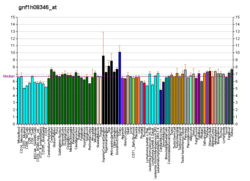NUFIP2
Nuclear fragile X mental retardation-interacting protein 2 is a protein that in humans is encoded by the NUFIP2 gene.[5][6][7]
Interactions
NUFIP2 has been shown to interact with FMR1.[5]
References
- 1 2 3 GRCh38: Ensembl release 89: ENSG00000108256 - Ensembl, May 2017
- 1 2 3 GRCm38: Ensembl release 89: ENSMUSG00000037857 - Ensembl, May 2017
- ↑ "Human PubMed Reference:".
- ↑ "Mouse PubMed Reference:".
- 1 2 Bardoni B, Castets M, Huot ME, Schenck A, Adinolfi S, Corbin F, Pastore A, Khandjian EW, Mandel JL (Jul 2003). "82-FIP, a novel FMRP (fragile X mental retardation protein) interacting protein, shows a cell cycle-dependent intracellular localization". Hum Mol Genet. 12 (14): 1689–98. PMID 12837692. doi:10.1093/hmg/ddg181.
- ↑ Ramos A, Hollingworth D, Adinolfi S, Castets M, Kelly G, Frenkiel TA, Bardoni B, Pastore A (Jan 2006). "The structure of the N-terminal domain of the fragile X mental retardation protein: a platform for protein-protein interaction". Structure. 14 (1): 21–31. PMID 16407062. doi:10.1016/j.str.2005.09.018.
- ↑ "Entrez Gene: NUFIP2 nuclear fragile X mental retardation protein interacting protein 2".
Further reading
- Bonaldo MF, Lennon G, Soares MB (1997). "Normalization and subtraction: two approaches to facilitate gene discovery.". Genome Res. 6 (9): 791–806. PMID 8889548. doi:10.1101/gr.6.9.791.
- Nagase T, Kikuno R, Ishikawa KI, et al. (2000). "Prediction of the coding sequences of unidentified human genes. XVI. The complete sequences of 150 new cDNA clones from brain which code for large proteins in vitro.". DNA Res. 7 (1): 65–73. PMID 10718198. doi:10.1093/dnares/7.1.65.
- Strausberg RL, Feingold EA, Grouse LH, et al. (2003). "Generation and initial analysis of more than 15,000 full-length human and mouse cDNA sequences.". Proc. Natl. Acad. Sci. U.S.A. 99 (26): 16899–903. PMC 139241
 . PMID 12477932. doi:10.1073/pnas.242603899.
. PMID 12477932. doi:10.1073/pnas.242603899.
- Ota T, Suzuki Y, Nishikawa T, et al. (2004). "Complete sequencing and characterization of 21,243 full-length human cDNAs.". Nat. Genet. 36 (1): 40–5. PMID 14702039. doi:10.1038/ng1285.
- Brill LM, Salomon AR, Ficarro SB, et al. (2004). "Robust phosphoproteomic profiling of tyrosine phosphorylation sites from human T cells using immobilized metal affinity chromatography and tandem mass spectrometry.". Anal. Chem. 76 (10): 2763–72. PMID 15144186. doi:10.1021/ac035352d.
- Jin J, Smith FD, Stark C, et al. (2004). "Proteomic, functional, and domain-based analysis of in vivo 14-3-3 binding proteins involved in cytoskeletal regulation and cellular organization.". Curr. Biol. 14 (16): 1436–50. PMID 15324660. doi:10.1016/j.cub.2004.07.051.
- Ballif BA, Villén J, Beausoleil SA, et al. (2005). "Phosphoproteomic analysis of the developing mouse brain.". Mol. Cell Proteomics. 3 (11): 1093–101. PMID 15345747. doi:10.1074/mcp.M400085-MCP200.
- Gerhard DS, Wagner L, Feingold EA, et al. (2004). "The status, quality, and expansion of the NIH full-length cDNA project: the Mammalian Gene Collection (MGC).". Genome Res. 14 (10B): 2121–7. PMC 528928
 . PMID 15489334. doi:10.1101/gr.2596504.
. PMID 15489334. doi:10.1101/gr.2596504.
- Beausoleil SA, Villén J, Gerber SA, et al. (2006). "A probability-based approach for high-throughput protein phosphorylation analysis and site localization.". Nat. Biotechnol. 24 (10): 1285–92. PMID 16964243. doi:10.1038/nbt1240.
- Olsen JV, Blagoev B, Gnad F, et al. (2006). "Global, in vivo, and site-specific phosphorylation dynamics in signaling networks.". Cell. 127 (3): 635–48. PMID 17081983. doi:10.1016/j.cell.2006.09.026.
 . PMID 12477932. doi:10.1073/pnas.242603899.
. PMID 12477932. doi:10.1073/pnas.242603899. . PMID 15489334. doi:10.1101/gr.2596504.
. PMID 15489334. doi:10.1101/gr.2596504.



